Animals have a particularly difficult time in the cold season. We show you the simple means you can use to help the little animals through the winter.

Frosty cold, icy wind and little food - the winter presents native animals with a special challenge. Birds in particular are fleeing south for this reason, where conditions are better in winter. The animals that stay in the garden in winter, on the other hand, go into hibernation or adapt to the harsher environmental conditions. In particular, they present the low food supply and the lack of retreat options in the garden extraordinarily difficult problems, but fortunately solved by us humans with a few simple tricks can become. You can find out here how you can best help the animals in winter.
contents
- These animals overwinter in the garden
- Make the garden animal-friendly in winter
- Help hedgehogs in winter
- Helping birds in winter
- Help squirrels in winter
- Help bees in winter
- Help butterflies and ladybugs in winter
- Help amphibians in winter
In winter, the garden often appears empty and uninhabited. In fact, only a few animals are looking to flee south – only migratory birds such as swallows and warblers as well as some types of butterflies such as the admiral set out on the arduous journey. However, most of the other animals remain in the garden and try to defy the winter here.
These animals overwinter in the garden
The most present are probably the sedentary birds like sparrows, robin or magpies, who also present their acrobatic flying skills in the garden in winter. But squirrels and raccoons can also be seen on the lawn from time to time when they wake up from hibernation to fill their stomachs. Hedgehogs and dormouse are almost never seen in winter, because they hibernate well hidden - nevertheless, they are often unnoticed guests in the garden.
Anyone who can offer an old barn or a dark shed also likes to house the bats in winter, which avoids snow and cold as much as possible. Even reptiles, amphibians and insects often spend the winter quietly and secretly in our gardens: toads and lizards seek shelter in holes in the ground, bumblebees remain in their burrows and wild bees like to spend the winter in dead wood. Only those can be really annoying ladybug attracted by the heat, they often find themselves in the cracks around the window and infiltrate our homes.
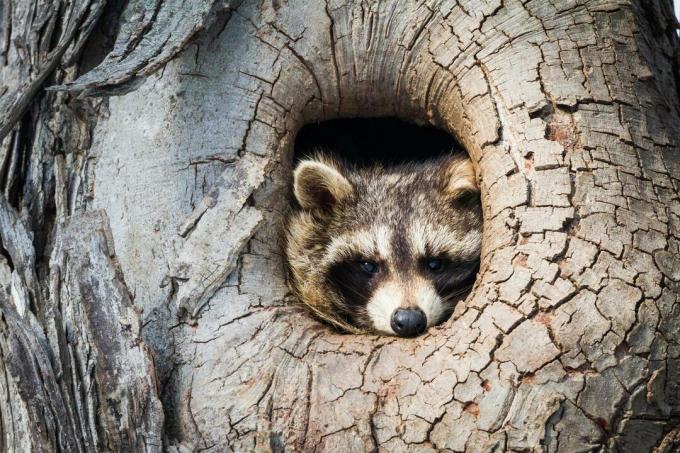
Make the garden animal-friendly in winter
As different as the various garden animals may be, many have the same requirements, especially in winter. Luckily, gardeners who want to make their property animal-friendly in winter can make several animal species happy at the same time. Plants such as mountain ash (Sorbus aucuparia) or wild roses (pink), which also bear fruit in winter, not only look wonderful, but also offer a good source of food for birds in particular, but also for other herbivores.
But you only make many animals really happy if you don't keep your garden meticulously organized: natural gardens with piles of leaves, dead wood and perennials that have not been cut back are ideal hiding places for insects, but birds and hedgehogs also find suitable winter quarters here. Garden sheds and tool sheds are particularly popular – especially insects such as ladybugs or Butterflies, but also edible dormouse or bats prefer to use the warm places as protection against the Weather.
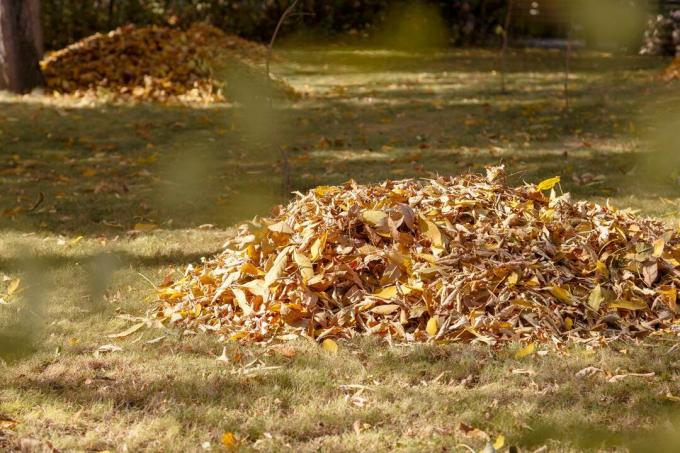
Help hedgehogs in winter
Hedgehogs are welcome guests in the garden, after all they not only look funny, but also like to eat pests such as snails. In winter, however, the hedgehog is dependent on our help, because it needs suitable quarters to be able to hibernate. Heaps of leaves and brushwood are its preferred retreat, which is why it is worth not removing all the leaves in the garden - this way you can offer the hedgehog a suitable shelter. But dense hedges or a warm garden shed can also serve as a suitable hiding place for hedgehogs.
If you want to be on the safe side, you can also buy a hedgehog house in a specialist shop or build it yourself: Das Due to its insulation, the brick house is a perfect protection against cold and weather and can also in small gardens be unobtrusively integrated. However, you should never check whether your house is actually inhabited - hedgehogs are out awakened from their hibernation and driven out of hiding, this can be a death sentence for the animals be. If you find particularly small hedgehogs in late autumn, a look at the scales can't hurt: Animals under 500 grams do not survive the winter on their own and should be nursed up before hibernation in consultation with the wildlife aid will. However, milk must not be used here - even if it is often recommended as food for hedgehogs, it is not suitable for the animals and can even make them sick. In our special article on Supporting hedgehogs in the fall see more information.

Helping birds in winter
blue tit, robin and wren – not all birds spend the winter in the warm south. But the winter also poses some problems for the feathered neighbors, because food in particular is also in the bird friendly garden often few and far between. It is therefore advisable to support the birds that have stayed here with some food in winter: Ein homemade bird feederin the garden is ideal for feeding the animals while also providing the opportunity to observe the interesting creatures up close. However, make sure that the aviary is attached as cat-proof as possible, otherwise the kindly meant help will quickly become a death trap. Fat balls in the net are also a possible source of danger, because the animals can get caught in them get tangled - better is the choice of feeding spirals, which are also hung in the trees be able.
Our Plantura fat balls are therefore completely without plastic nets. The energy-rich dumplings also consist of pure insect fat and valuable nuts, berries and seeds - for a rich feeding of wild birds.

Plantura fat balls
Sustainable fat balls without a net,
Species-appropriate wild bird food with insect fat for year-round feeding
A little tip: A good basic food, which is eaten by almost all bird species, are sunflower seeds. But not only do many birds lack food, there are also few natural retreats such as caves and niches. This can be remedied by nesting boxes, which the birds not only like to use for breeding, but also as protection against the weather in winter. So if you want to create new quarters for your garden birds, you shouldn't wait until spring, but look for a suitable location in autumn.

Help squirrels in winter
Squirrels are great roommates in the garden, especially in autumn: In search of food, the lively animals dart from tree to tree and are particularly easy to observe. The reason for the time-consuming search for food is the approaching winter. Because squirrels don't hibernate in their dens, they just hibernate, so they need to stock up on energy-rich food to get through the cold season. Be ready walnut tree (Juglans regia) or a hazelnut bush (Corylus avellana) can help the small animals to replenish their food reserves. However, one is even better Feeder for squirrels: Equipped with nuts and seeds, it helps the cute animals through bottlenecks in winter and ensures an adequate supply of food.
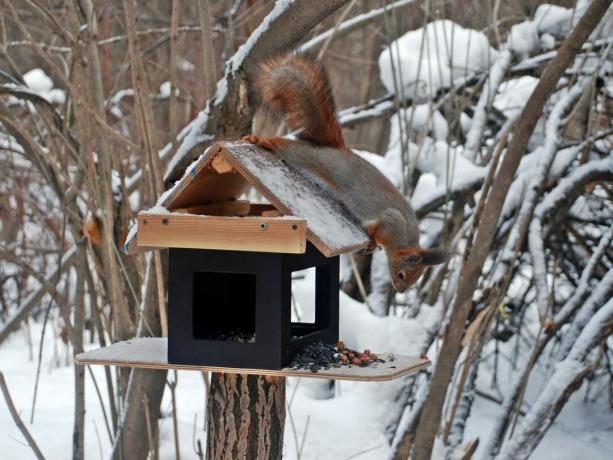
Help bees in winter
bees are probably the best known beneficials, which are found in a garden and are therefore gladly supported by gardeners. Especially in winter, the animals are dependent on the help of humans: While honey bees can return to their hive, wild bees often lack natural retreat options. Since many wild bee species hibernate in hollow stalks or deadwood, it's worth doing the fall cleaning in the To let the garden fall out and give faded perennials and old wood a place in the garden grant.
Insect hotels are also suitable for overwintering in the garden - these should ideally be protected from the wind as much as possible. By the way, you can tell whether the individual corridors within the insect hotel are occupied by the lock that the insects put on at the entrance to their cabin. But even before winter you can do something for the wild bees: ivy (Hedera helix) is ideal due to its late flowering to offer the bees a last feast before the consuming winter.
tip: More on this, what bees do in winter, you can find out in our special article.

Help butterflies and ladybugs in winter
Butterflies in Germany have very different tactics in winter to survive the frost and cold. Some species such as the painted lady make their way south, others overwinter as eggs or larvae and some even as adults. So that butterflies like the swallowtail, which hangs close to the ground as a pupa, end the winter survive, it is worth not cutting back a few plants, but allowing them to survive the winter permit.
The peacock moth, which overwinters as an adult butterfly, is just as happy about a warm spot as the peacock Ladybugs: Piles of brushwood or leaves offer the animals protection, but the garden shed is also a popular choice as a retreat. So that the animals can find refuge in this, it makes sense to leave the window or skylight open a crack in spring and autumn. The brimstone butterfly, on the other hand, does not need any special help - thanks to its natural frost protection, the delicate butterfly can even survive temperatures of down to -20 °C. Detailed information on how butterflies hibernate, can be found in our special article.
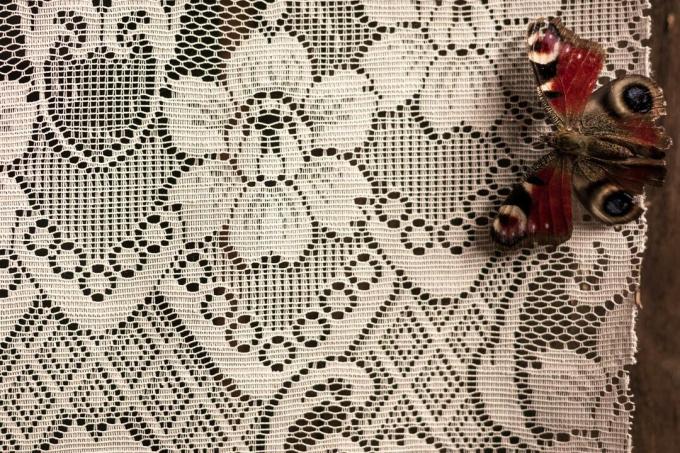
Help amphibians in winter
Even if toads and frogs are not everyone's favourites, they are a real asset in the garden, after all they eat all kinds of pests. To ensure that the useful animals survive the winter well, you can support them with a few tricks. Common toads crawl into frost-free leaf and compost heaps and burrows in winter. Those who can offer these elements in their garden ensure that the animals' chances of survival increase considerably.
Unfortunately, the search for suitable accommodation is also the greatest risk for the small animals: During the so-called toad migration, numerous animals follow in their search a suitable winter quarters when crossing streets, others crawl into cellar shafts and in the spring are no longer able to get by on their own to free. This can be remedied by special safety fences that either separate the street from the property or close off any hiding places in the basement.
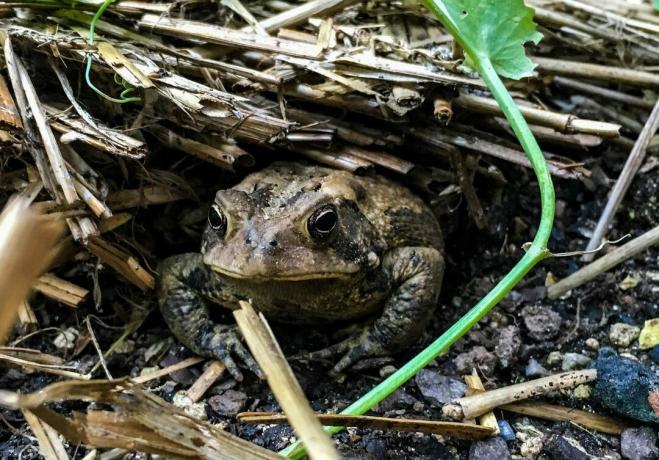
Many frog species, on the other hand, overwinter in water, for example at the bottom of a garden pond. It should be noted that the pond must be at least one meter deep - this is the only way to guarantee that it will not completely freeze over, even in severe frost. Good oxygen saturation in the water is also important running filter pump or by reeds or special underwater plants can. On the other hand, breaking up the top layer of ice should be avoided, as this leads to stress for the animals and can therefore mean their death.
If you are now further interested in the protection of animals in the garden, you will find our 8 tips here Conservation in the garden.
...and receive concentrated plant knowledge and inspiration directly in your e-mail inbox every Sunday!
